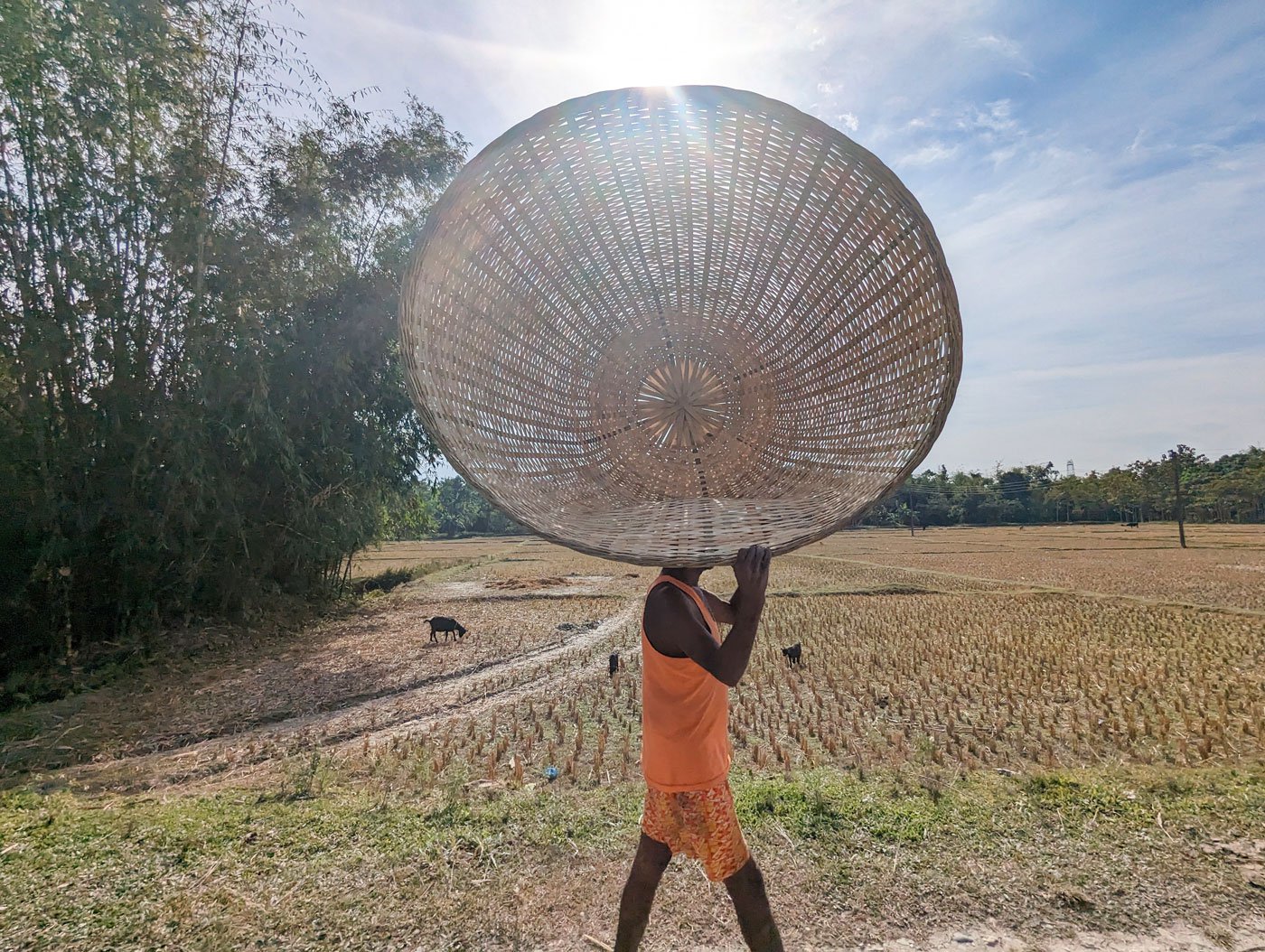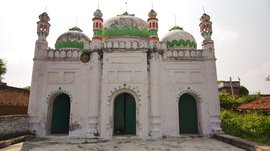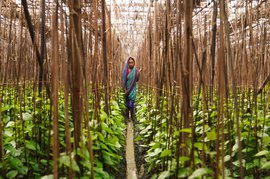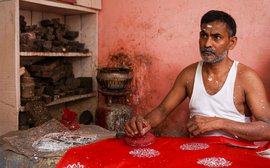“The people of West Bengal are unable to make a duli .”
Baban Mahato says this in a matter-of-fact tone about the gigantic dhaan dhorar duli that he crafts – upto six feet tall and four feet wide – to store paddy.
Just in case we didn’t catch it the first time,
the craftsman from neighbouring Bihar adds, “making a
duli
is not easy.” He goes
to reel off the many stages: “There is a lot of work starting from
kanda sadhna, kaam sadhna, talli bithana,
khada karna, bunai karna, teri chadhana
[preparing the longitudinal bamboo
slips and horizontal slips, laying the circular framework, making the basket
stand, weaving it to completion, and putting in the finishing interlacements].”
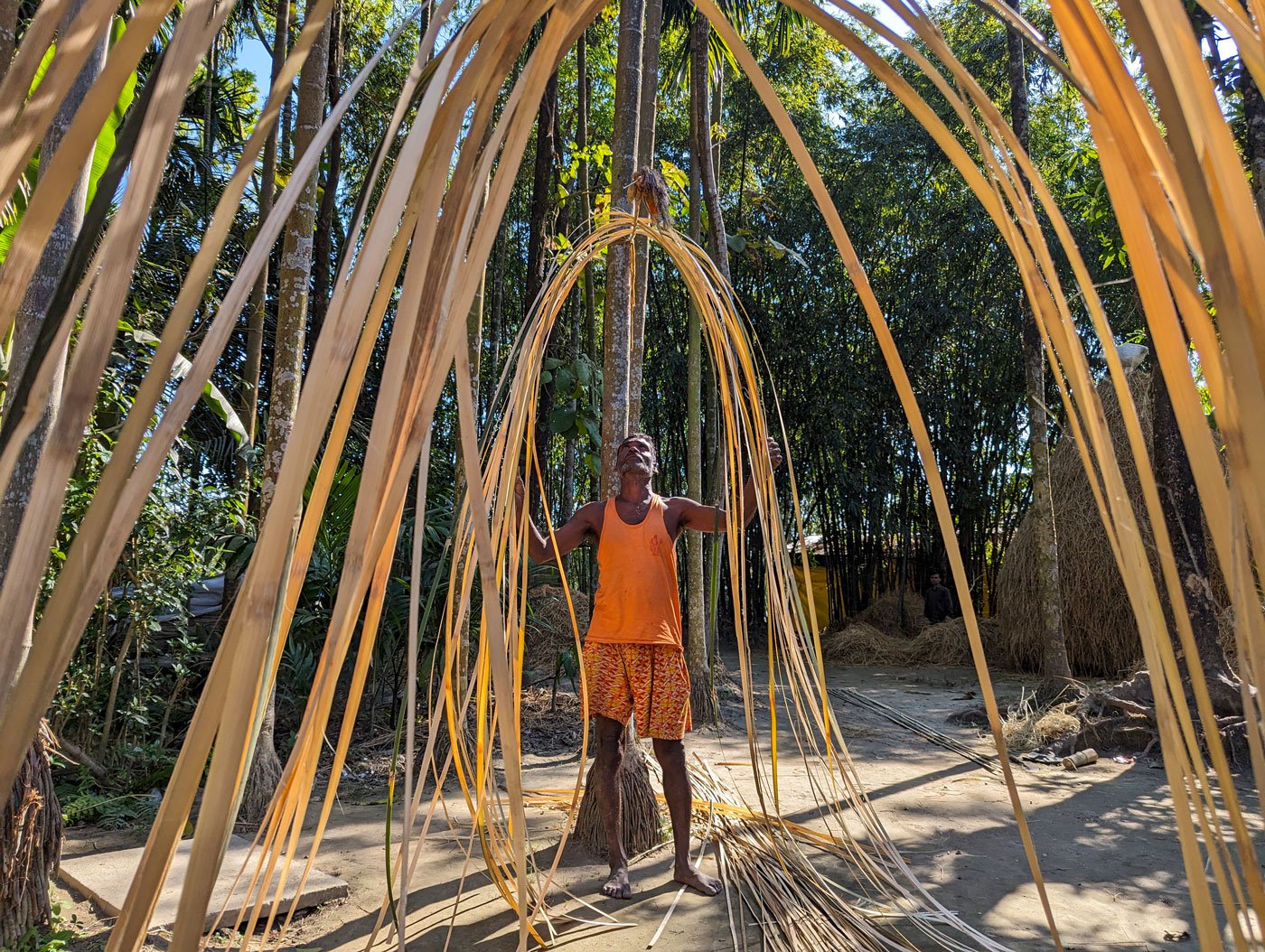
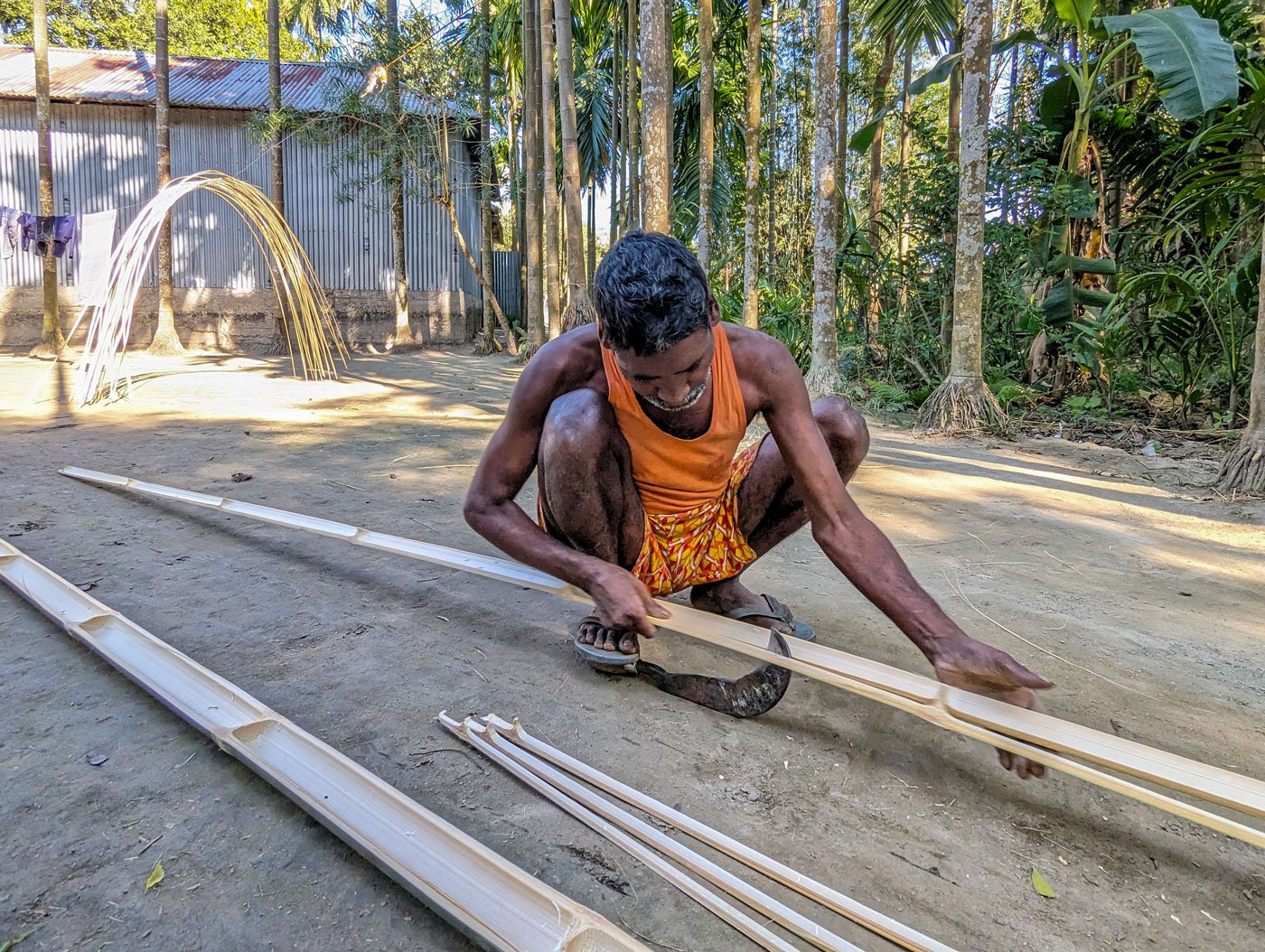
Baban Mahato migrates to West Bengal’s Alipurduar district from Bihar to make bamboo baskets . To prepare them for weaving, he dries the bamboo stems in the sun (left) after he splits it (right)
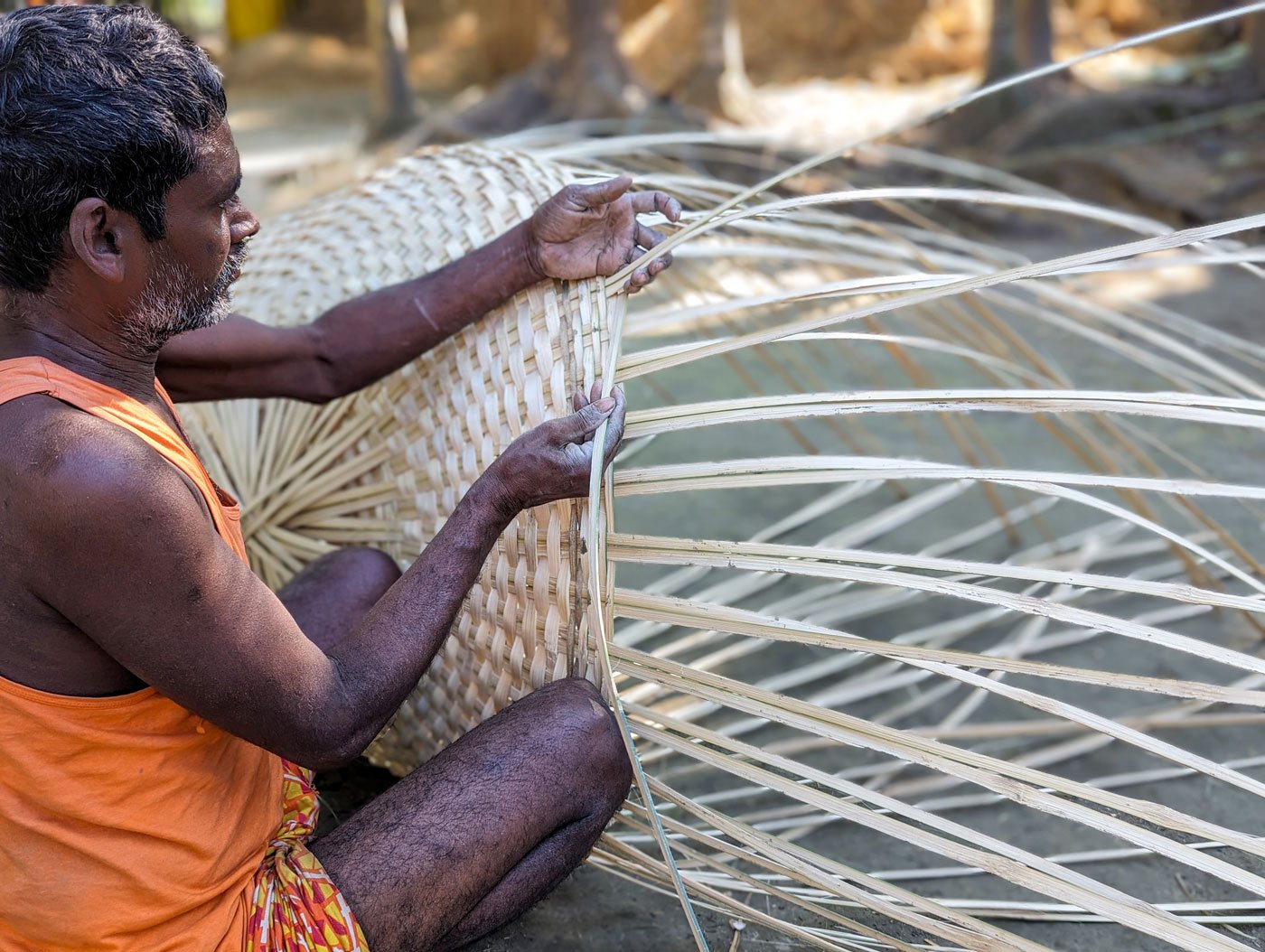
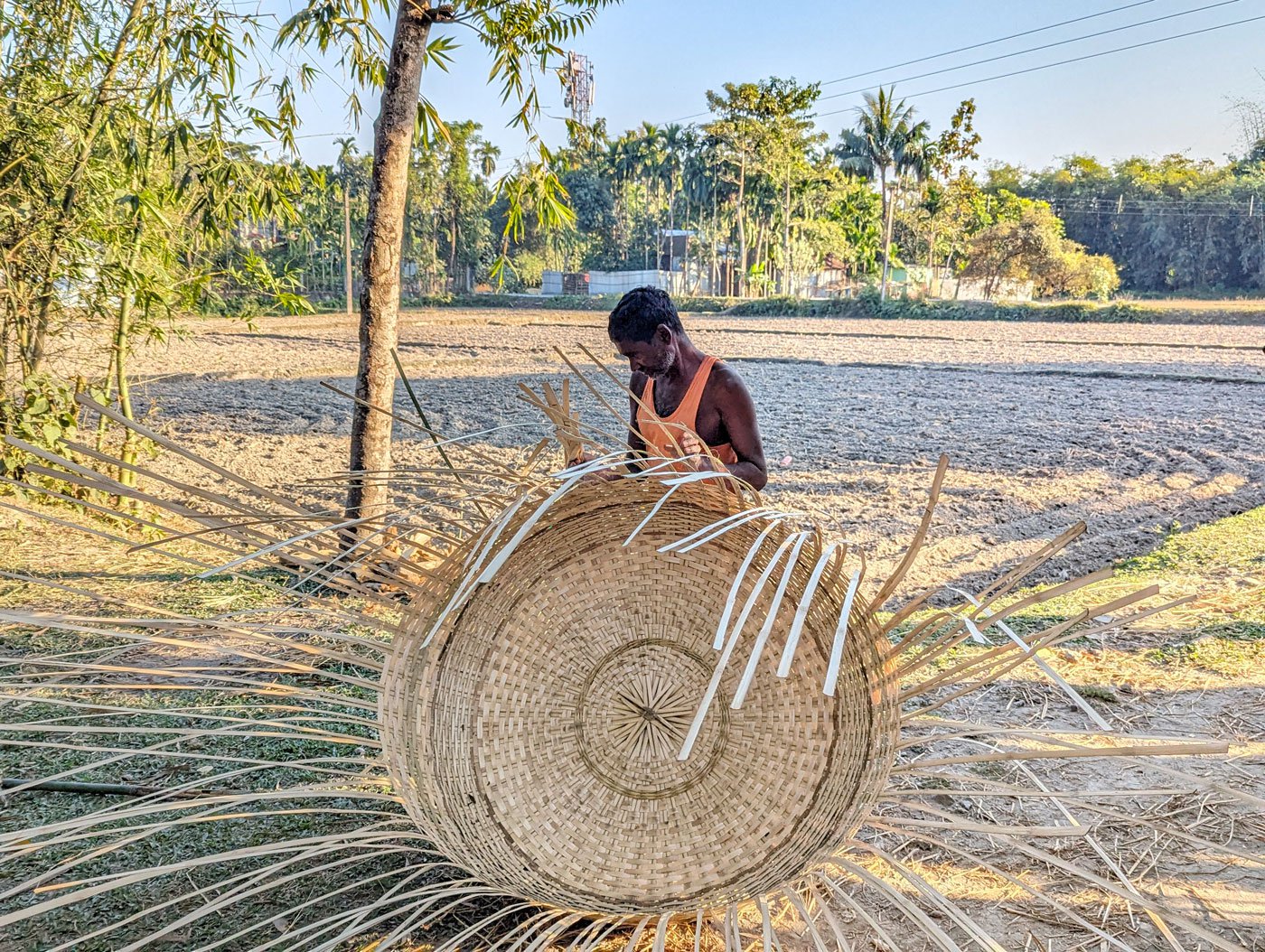
Baban's fingers move deftly as he weaves (left) the baskets. Once he completes the base, he keeps turning the basket (right) to make it stand
The 52-year-old Baban has been doing this for the last four decades. “Since my childhood my parents taught me only this work. They did only this work. All Bind people make the duli . They also make tokris [smaller baskets], catch fish, and row the boat.”
Baban is from Bihar’s Bind community, listed as Extremely Backward Class (EBC) in the state (Caste Census 2022-23). Most duli craftsmen, he says, are from the Bind community, but it is also done by people from the Kanu and Halwai communities (also EBC), who have picked up the skill after decades of living in close proximity to Bind people.
“I work with the estimation of my hand. Even if my eyes are closed, or it's dark outside, the intelligence of my hands is enough to guide me,” says Baban. He begins by slicing a horizontal cross-section of the bamboo, splitting it into 104 pliable strips, a task calling for great dexterity. Then using precise calculations, the circular bamboo framework is laid out measuring “ chay ya saat haath [roughly 9 to 10 feet]" in diameter, depending on the desired volume. A ‘haath’ is the measure of the hand from the tip of the middle finger to the elbow, widely used by artisan groups across India as a unit of measurement; it roughly equals 18 inches.
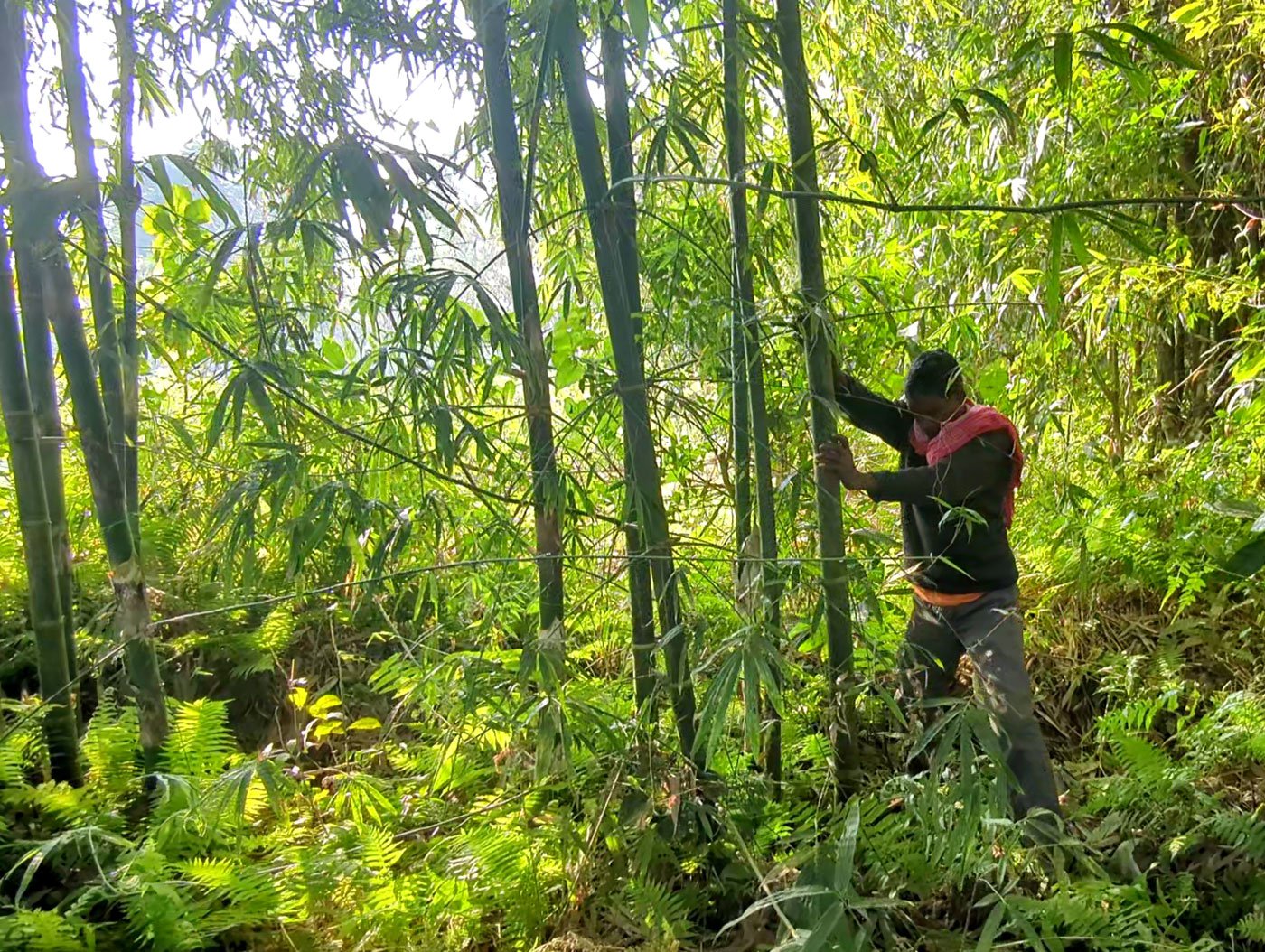
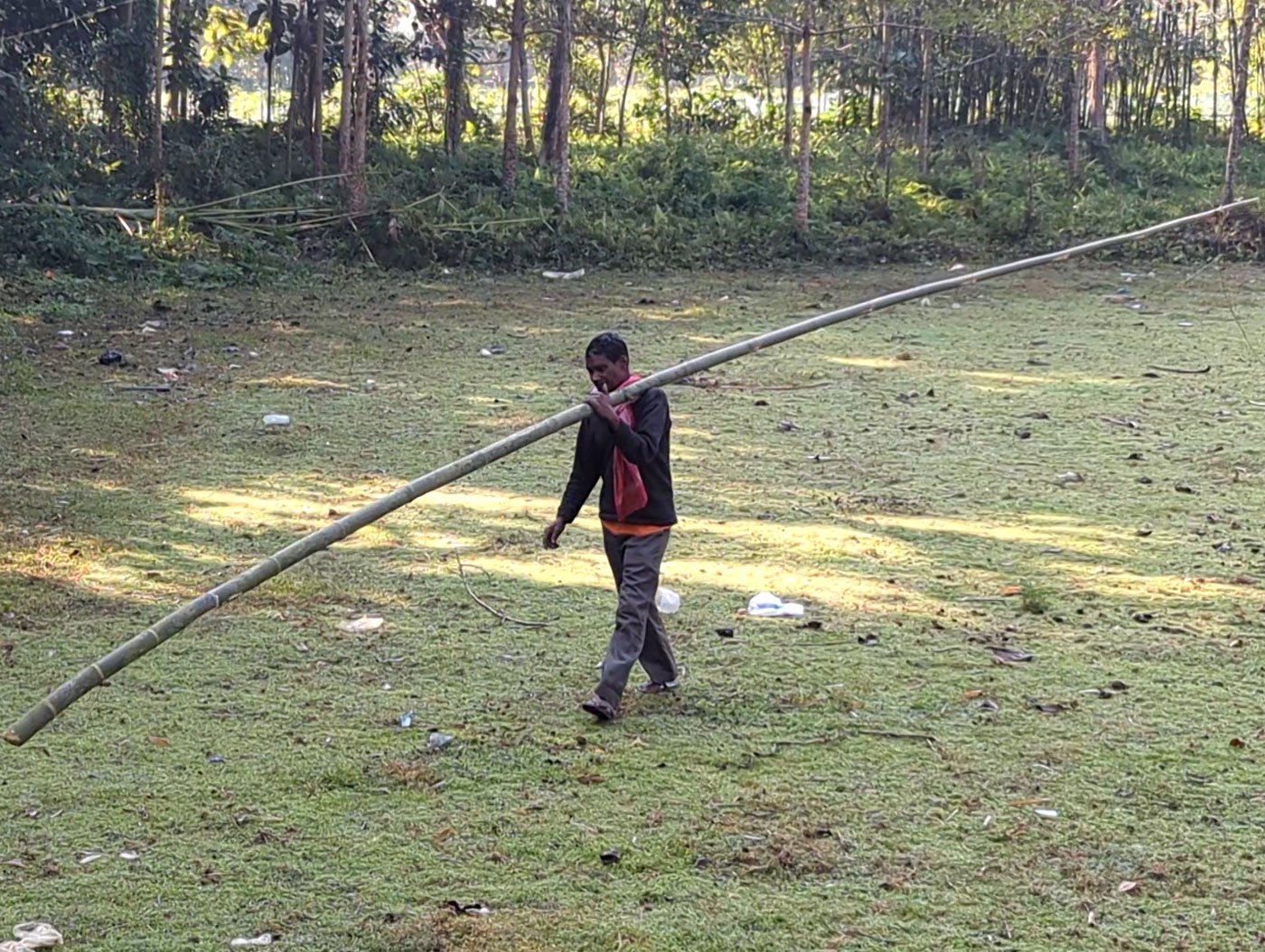
The weaver goes into the bamboo thicket to identify a suitable stem (left) and brings it back to his workspace (right)
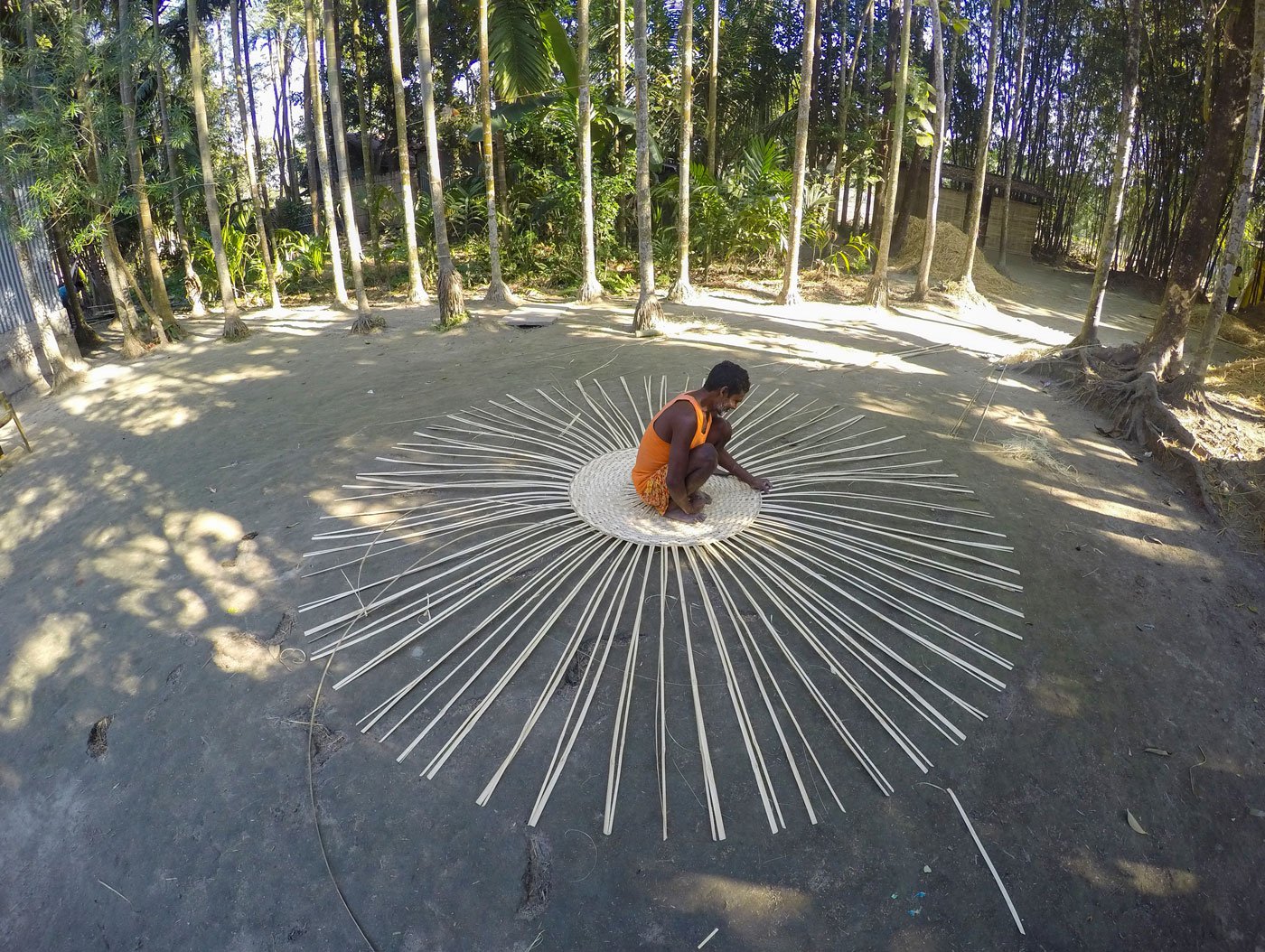
Baban prepares the circular base of the duli basket to a width of three feet by interweaving the bamboo splits into it
PARI is speaking to Baban in Alipurduar district (earlier Jalpaiguri). It is 600 kilometres from his home in Bihar’s Bhagwani Chhapra from where he travels annually to the northern plains of West Bengal for work, arriving in the month of Kartik (October-November) when the kharif paddy crop is ready for harvest. He will stay on for the next two months, making and selling the duli .
He’s not alone. “Every haat [weekly market] in the Alipurduar and Cooch Behar districts of Bengal has duli makers from our Bhagwani Chhapra village,” says Puran Saha. He too is a duli maker who annually migrates from Bihar to the Dodear haat in Khagrabari town in Cooch Behar district. Most migrants arriving for this work team up in groups of five to 10. They choose a haat and set up base there, living in makeshift tents.
Baban first arrived in West Bengal when he was 13 years old. He came along with his guru, Ram Parbesh Mahato. “I have accompanied my guru on his travels for 15 years. Only then have I been able to understand it [making a duli] fully,” says Baban, who also comes from a family of duli craftsmen.
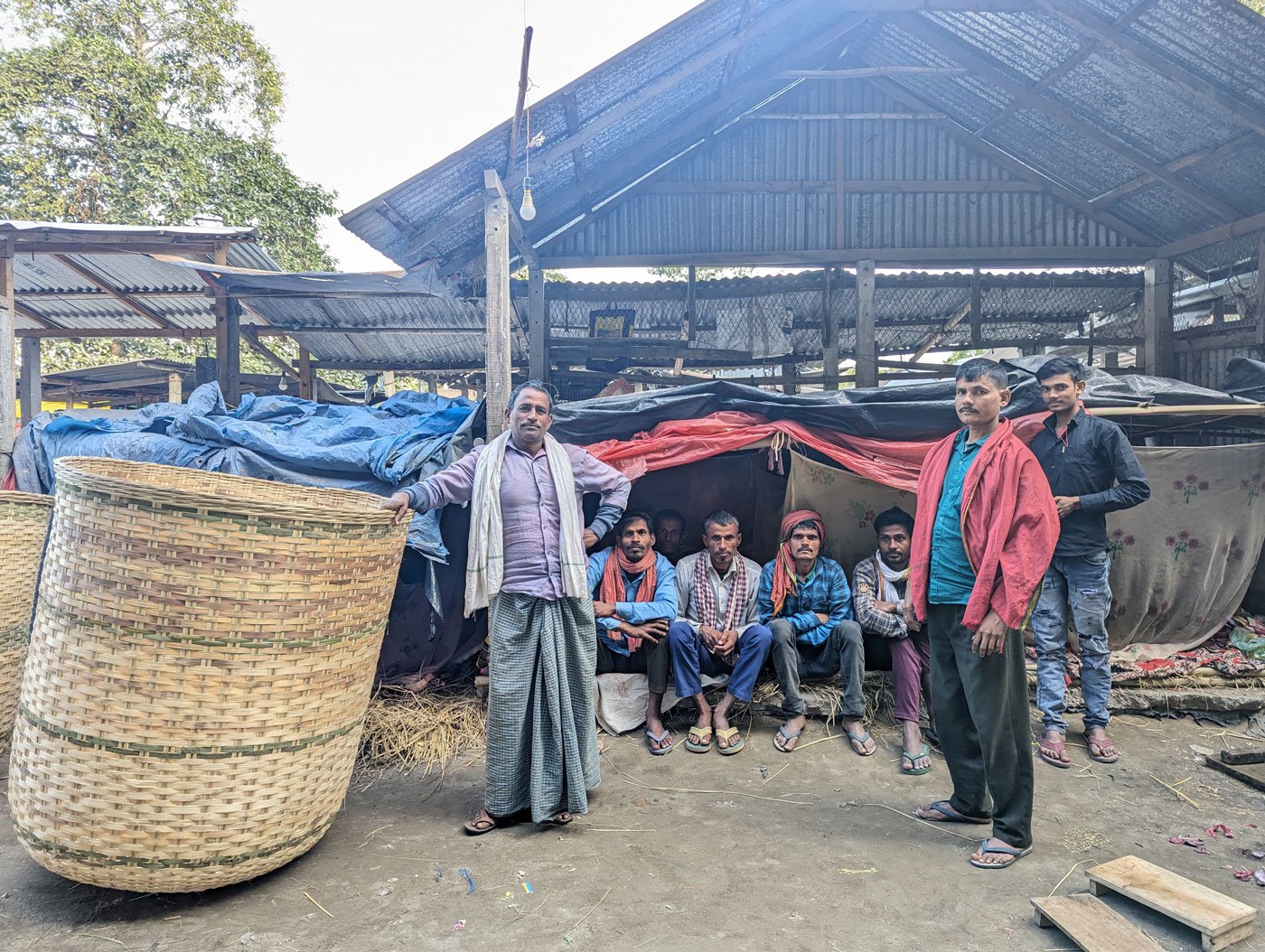
A group of basket-weavers at a weekly haat in Mathura, Alipurduar standing in front of their makeshift tents where they live, make and sell the dulis
*****
Baban starts the day by lighting a fire. It's too cold to sleep inside his makeshift home, so he chooses to sit by the fire on the road outside. “I wake up at 3 a.m. everyday. I feel cold at night. Because of the cold, I get out of my bed, light a fire outside and sit by it.” An hour later he starts work, and although it’s still dark outside, the dim street light is enough for him to begin.
He says that integral to the process of making the duli basket is the selection of the right kind of bamboo. “A three-year-old bamboo is the best for this purpose because it can be easily split, and it is suitably thick,” says Baban.
Laying the circular bamboo framework using the right calculations is tough, and he uses a tool called dao (sickle). For the next 15 hours he will only break for meals and a bidi (smoke).
A typical
duli
is 5 feet in height and 4 feet in
diameter. Baban can make two
duli
baskets
a day with the help of his son, and sell them in the weekly Mathura
haat
on Mondays in Alipurduar district.
“When I go to the haat, I carry
duli
in
various sizes: to hold 10
mann
, 15
mann
, 20
mann
, 25
mann
paddy.” One
mann
equals 40 kilograms, so a 10
mann
duli
can hold 400 kilos of paddy. Baban customises
duli
sizes for his customers based on the weight they want it to
hold. The
duli
sizes may vary from 5
to 8 feet in height based on the volume.
In my childhood my parents taught me how to make a duli . They themselves did only this work
“When the harvest season begins, we get 600 to 800 rupees for a duli . When the season is ending, the demand is less so I sell the same thing cheaper. For an additional earning of 50 rupees, I will deliver the basket as well,” he says.
One duli weighs eight kilos and Baban can carry as many as three dulis (weighing roughly 25 kilos) on his head. “Can I not carry the burden of 25 kilos on my head for some time?” he asks, adding that it’s not a big deal.
As Baban walks through the weekly haat where he sets up shop, he nods to his fellow villagers from Bihar, and points to the shops that belong to the members of his community, and also the local Bengalis who are helpful. “ Sab jaan pehchaan ke hain . [All the faces are familiar],” he says. “Even if I don’t have a single penny, and I look for rice, dal , and roti , they will give it all, irrespective of whether I have the money or not,” he adds.
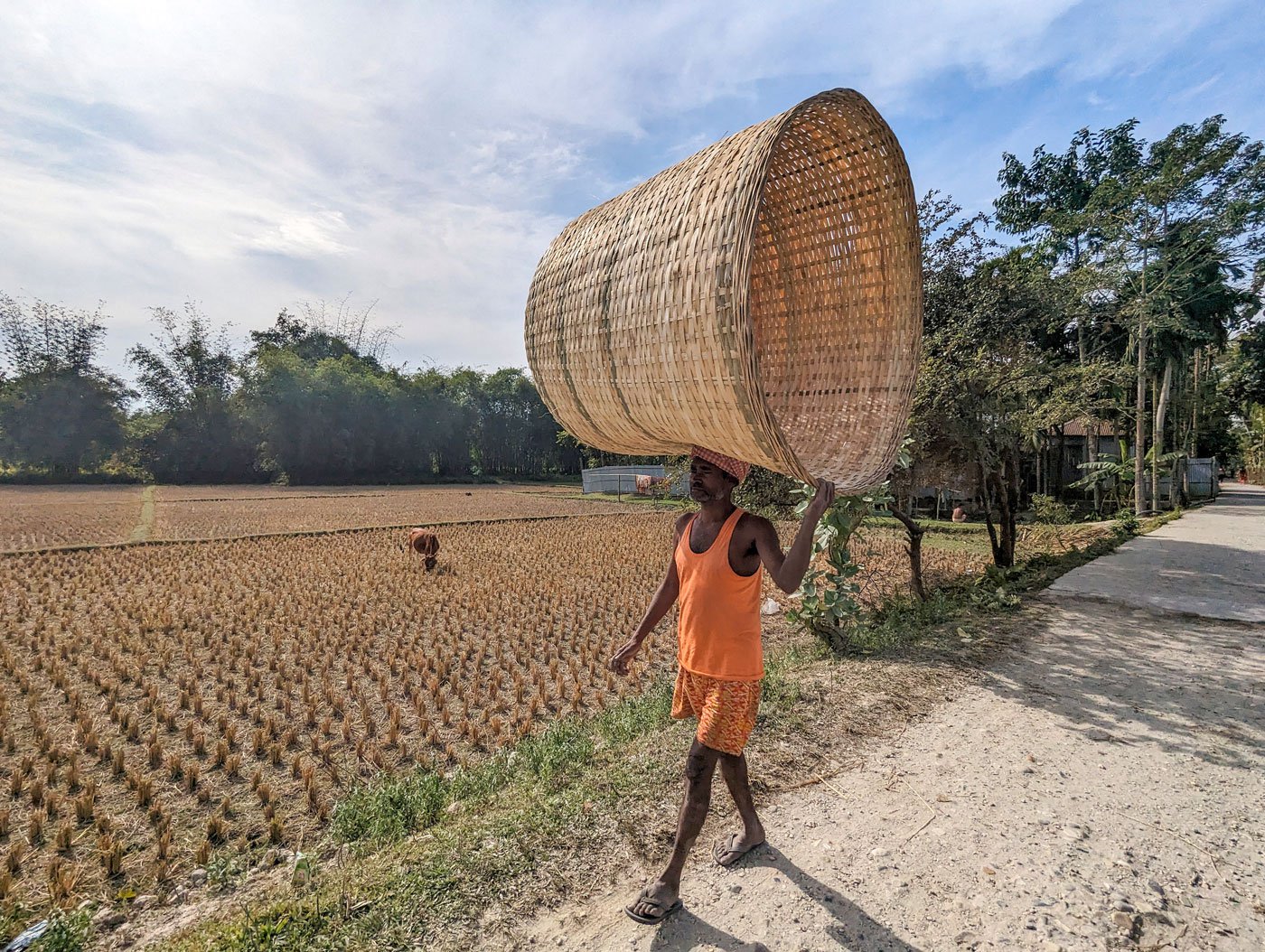
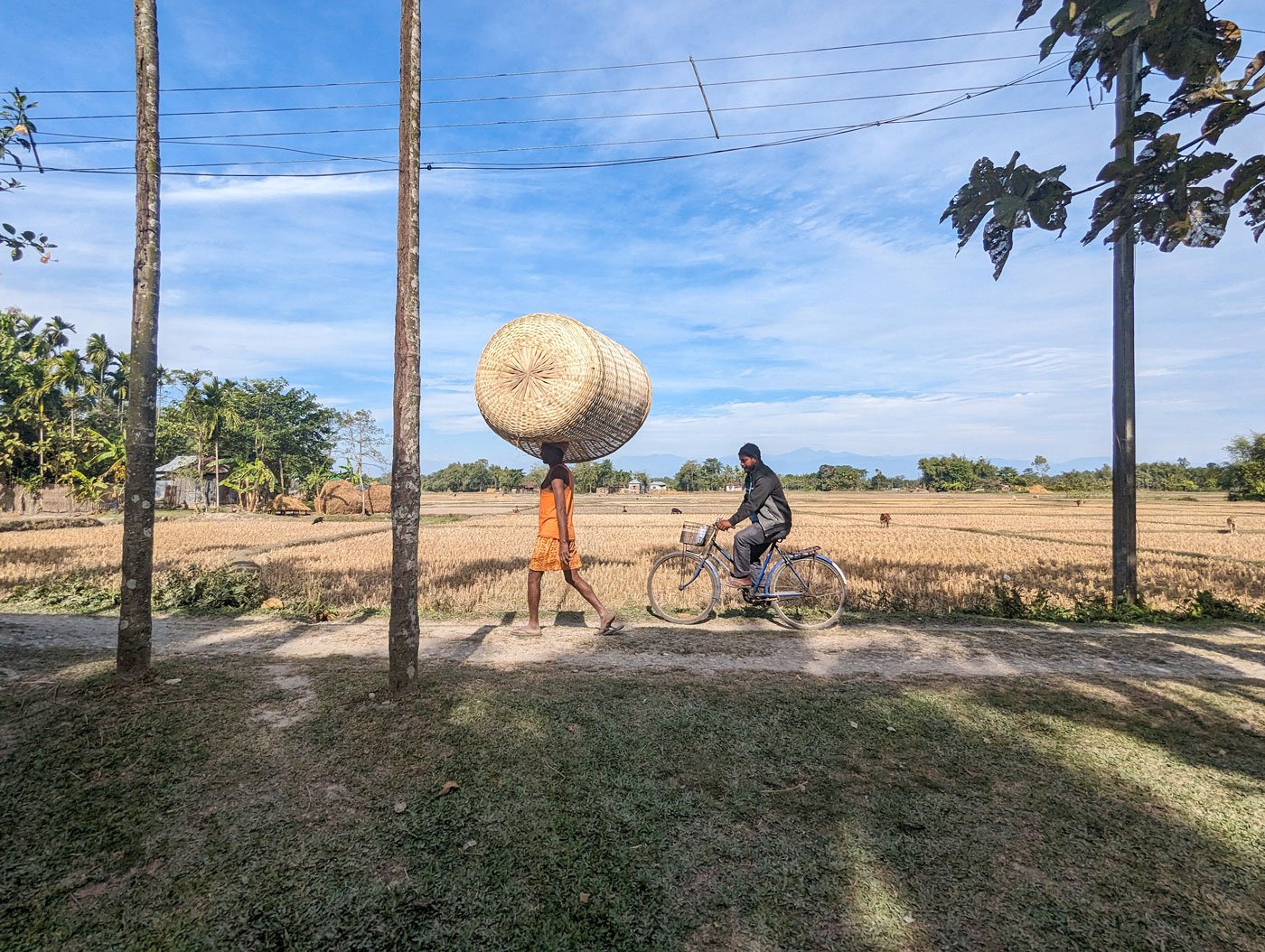
Baban carrying a duli to deliver to a customer (left) who cycles behind him (right)
His nomadic life has given him a fluency beyond his native Bhojpuri. He speaks Hindi, Bengali and Assamese, and understands Mechiya – the language of the Mech community who live in his neighbourhood in Dakshin Chakoakheti, Alipurduar district (earlier in Jalpaiguri district).
He says he buys a couple of shots of alcohol for Rs. 10 a day as, “all the hard labour makes my body sore. The alcohol makes it easier by numbing the pain.”
Although his fellow Biharis live together, Baban prefers to live by himself: “ If I have to eat for 50 rupees, and there are people along with me, they will say, ‘I want my share!’ That is why I choose to eat alone, and stay alone. That way whatever I eat is mine, whatever I earn is mine.”
He says there are few
livelihood opportunities in Bihar for Bind people, and so they have been
migrating like this for generations. Baban’s 30-year-old son, Arjun Mahato has
also travelled with him when he was young. Now he works in Mumbai as a painter.
“Our home state Bihar does not have enough for securing an income. Sand mining
is the only industry here…and all of Bihar cannot be reliant on that.”
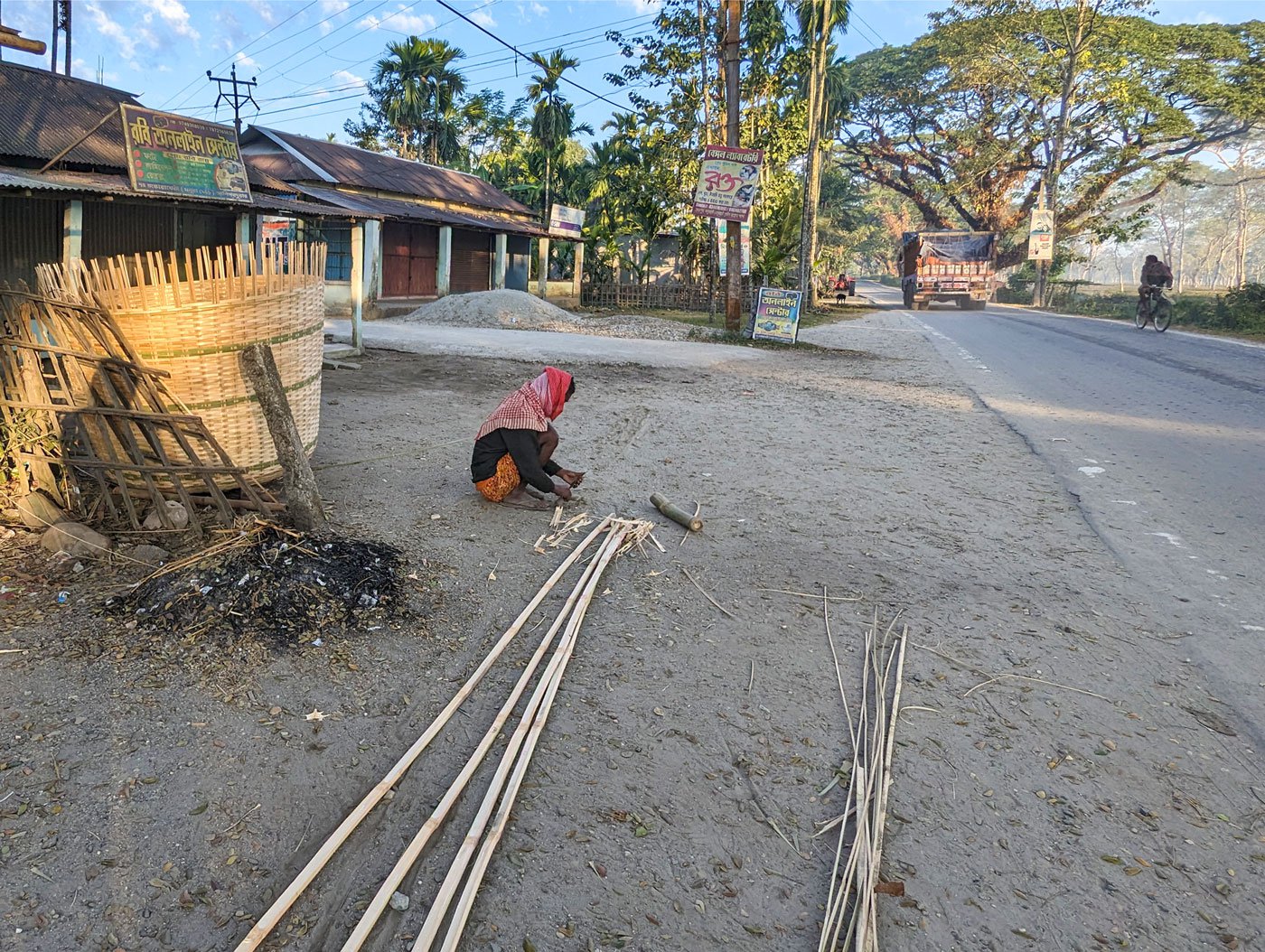
Between October to December every year, Baban lives and works on the highway in Alipurduar, West Bengal
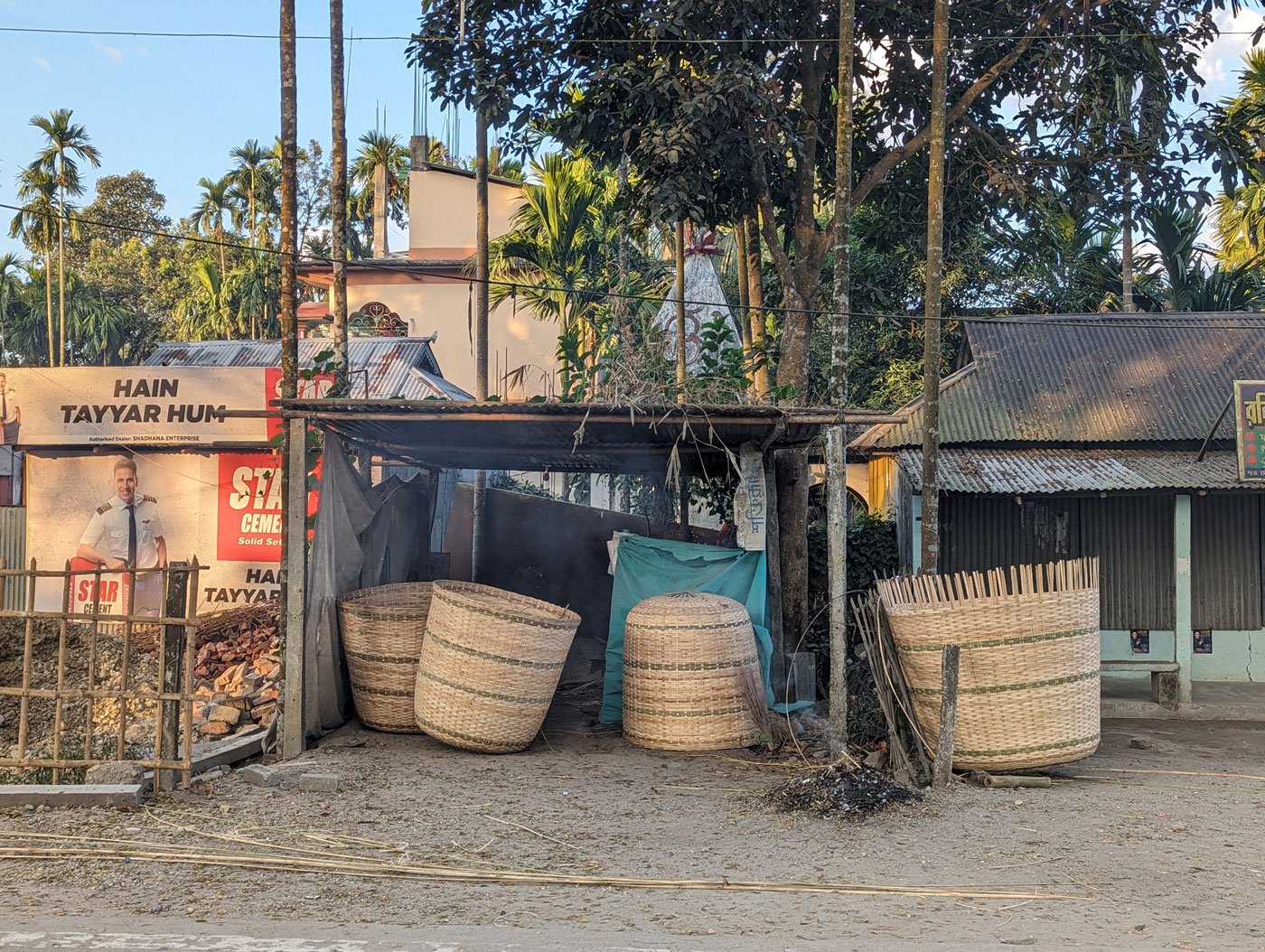
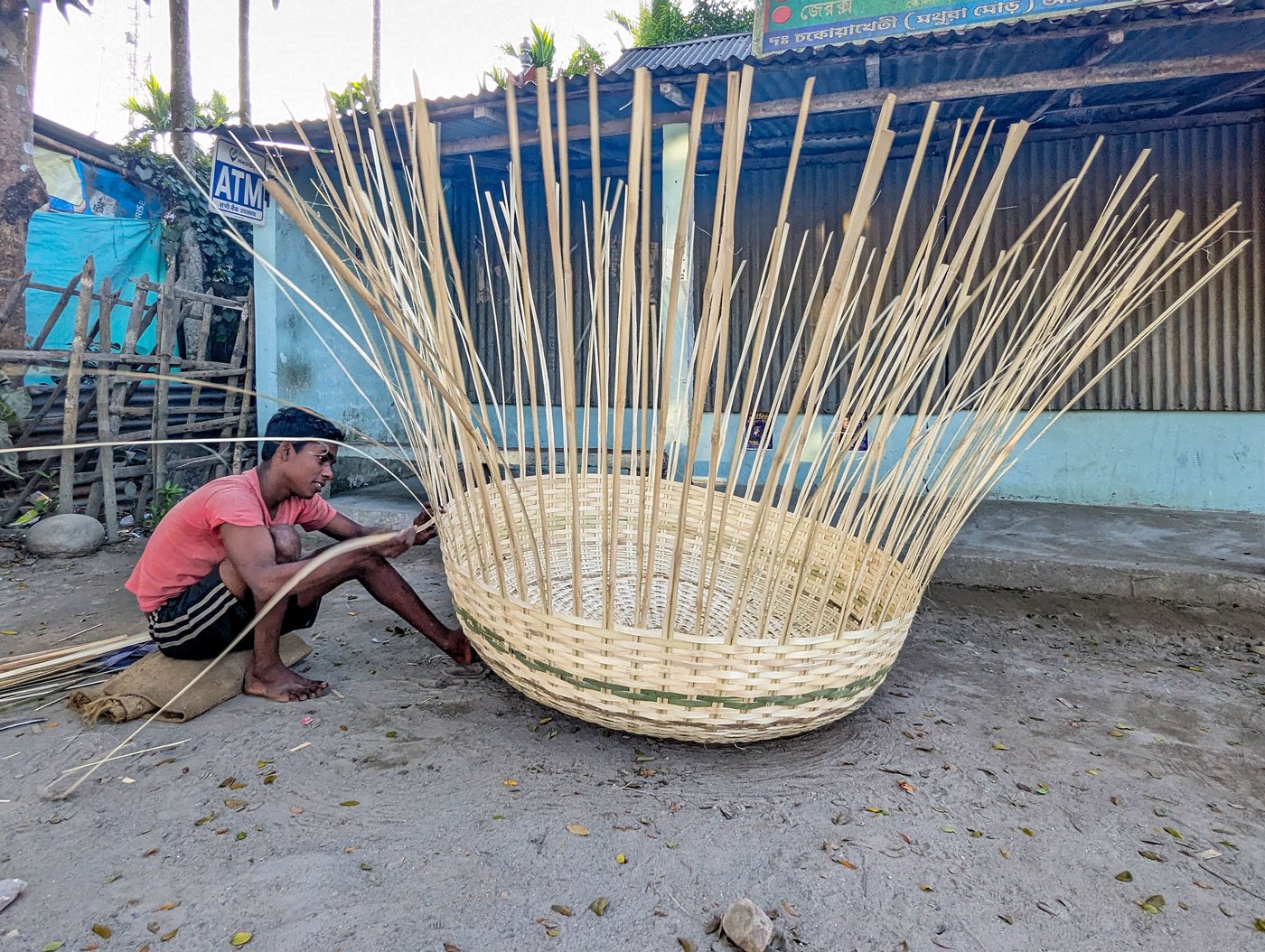
Left: The makeshift tarpaulin is Baban's temporary residence where he also makes the dulis. Right: His son Chandan finishes weaving the basket after Baban completes the crucial stages
Chandan, the youngest of Baban’s eight children, has accompanied him this year (2023). They have set up a makeshift home near National Highway-17 that runs from West Bengal to Assam, past tea gardens. Their home is a garage with loosely draped tarpaulin on three sides, and a tin roof, a mud chulha (stove), a bed and some storage space for the duli baskets.
The father and son use open spaces by the road to defecate; for bathing, they take water from the hand pump nearby. “I have no problems staying in these conditions. Mein hamesha apne kaam ke sur mein rehta hoon [I am always in the rhythm of my work],” says Baban. He makes and sells duli in the outer section, and cooks and sleeps in the inside.
When it’s time to leave and go back home, the bamboo craftsman says it's a painful parting: “ Maa, my landlady, has packed me a bunch of home-grown tej-patta [bay leaves] from her garden to take home.”
*****
The arrival of plastic sacks to store paddy, and changing patterns of processing and storage are impacting the livelihood of the duli makers. “Our work has taken a hit in the last five years because of upcoming rice mills in the area. The farmers sell their paddy to the mills directly from the fields for further processing, instead of storing it like before. People have also begun to use a lot of plastic sacks for storage,” a group of duli makers from Bihar tell PARI.
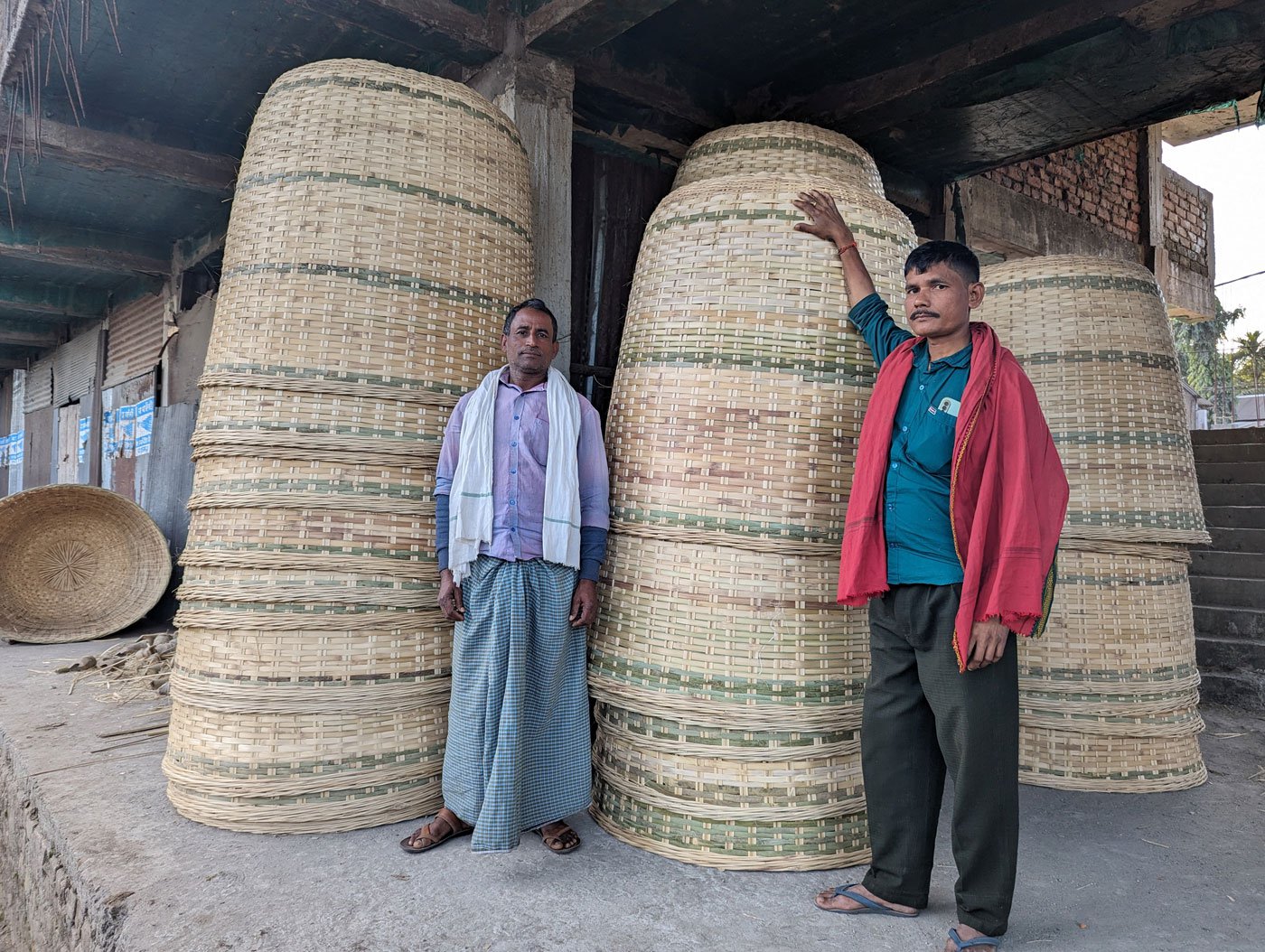
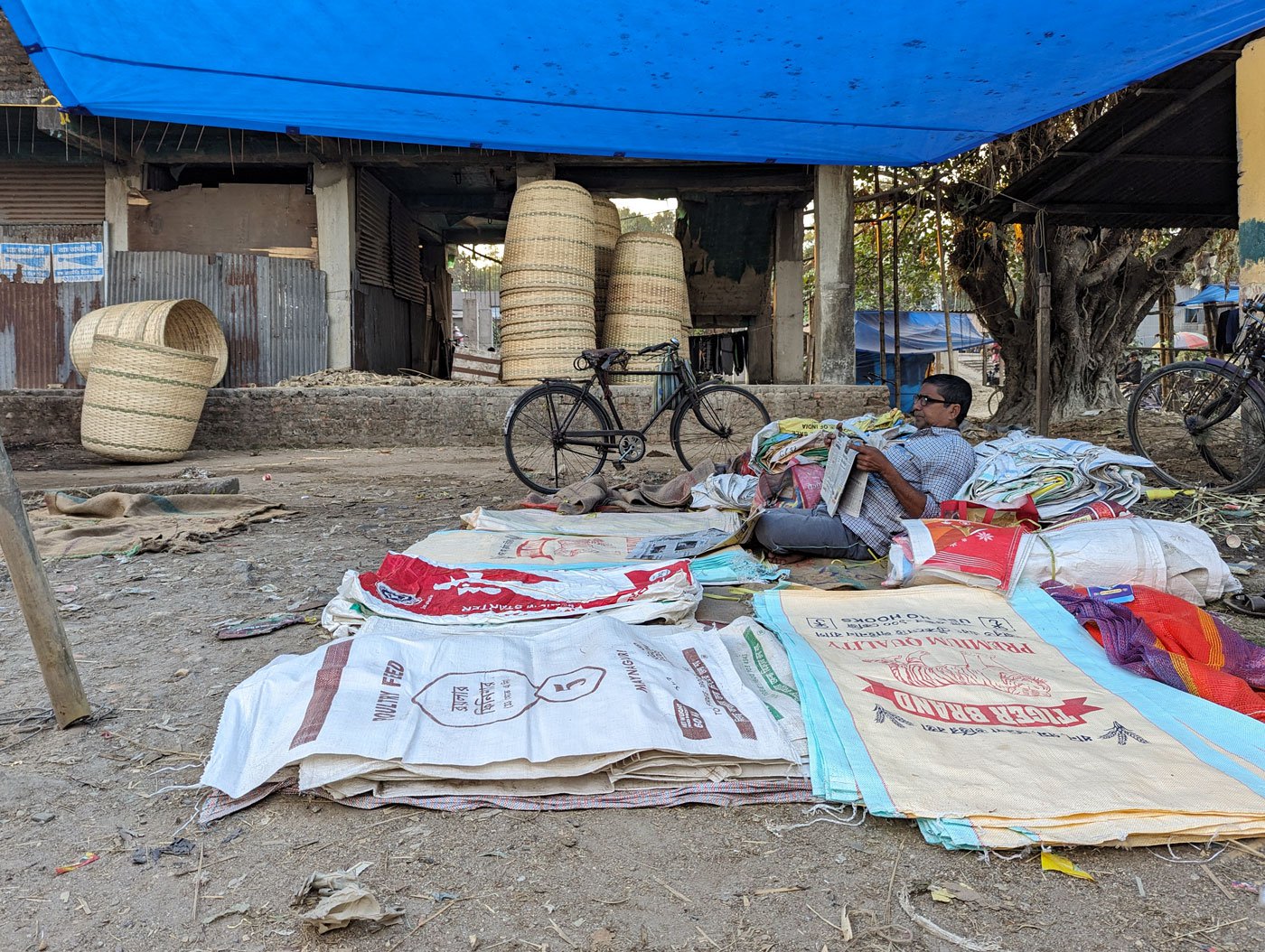
Left: Duli makers have not been able to sell all their baskets this season (2024) . Right: Farmers prefer the basta (plastic sacks) as they are cheaper and easier to store
Making other, smaller sized baskets ( tokris ) is a possibility, but they want to keep the peace with the locals who also make it, and have requested them, ‘dekho bhai, yeh mat banao, apna bada wala duli banao.. Humlog ka pet mein laat mat maro” [brother, please don’t make the small baskets. You make your big baskets. Don’t take our livelihood away from us’].
At the haats in Cooch Behar and Alipurduar districts, a basta (plastic sack) is Rs. 20 for a piece, while a single duli is priced at between Rs. 600 to 1,000. The basta can hold 40 kilos of rice, whereas a typical duli can hold 500 kilos of rice.
Sushila Rai is a paddy farmer who prefers a duli. The 50-year-old from Dakshin Chakoyakheti village in Alipurduar says, “if we store the paddy in a plastic sack, it gets infested with black bugs [rice weevils]. So, we use the duli . We keep a large stock of rice for personal consumption for the year.”
West Bengal is the
largest producer of rice in the country (13 per cent of India’s total rice
production) with 16.76 million tonnes annually in 2021-22 says this
report
of the Department of
Agriculture and Farmer Welfare.
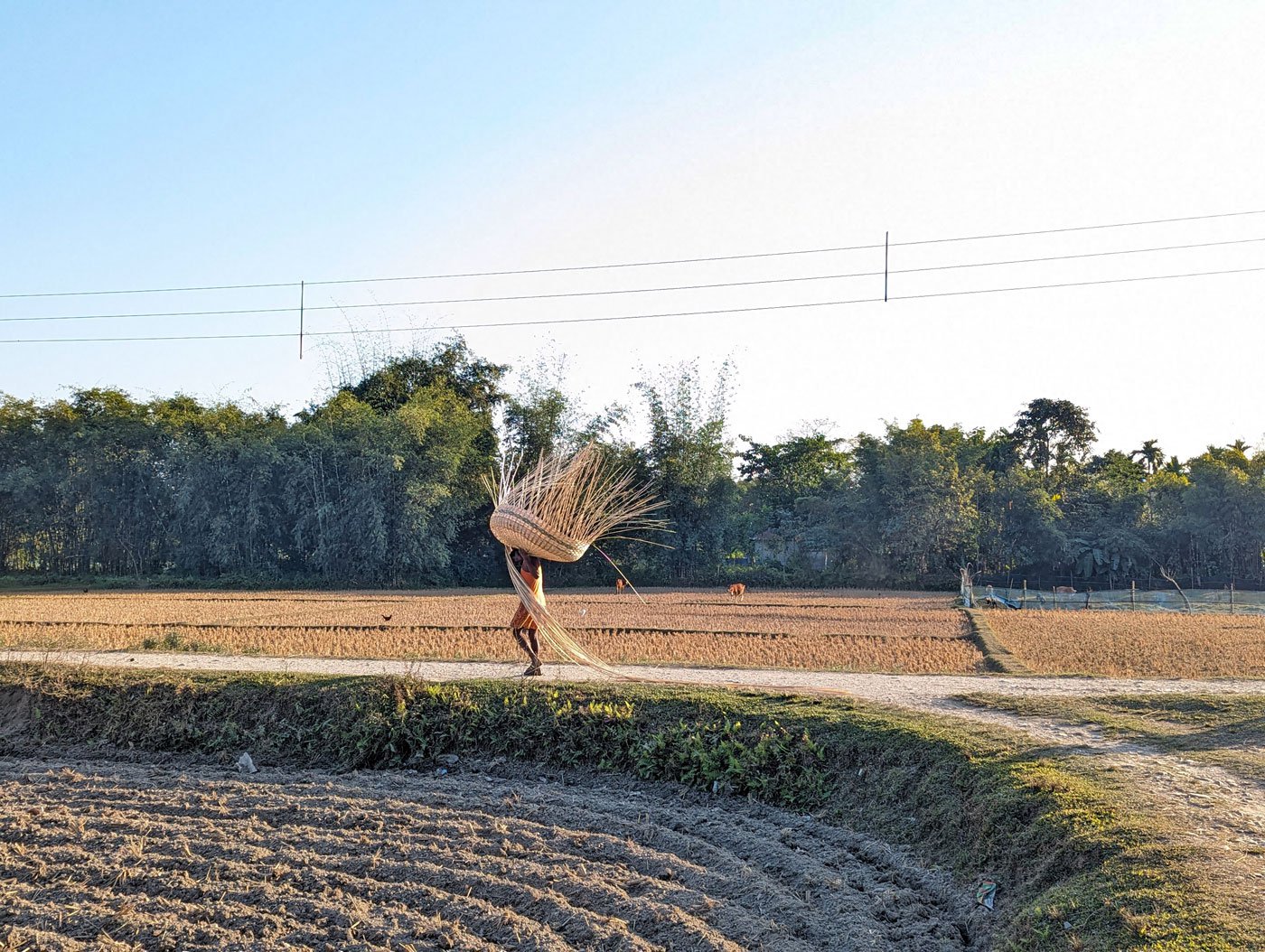
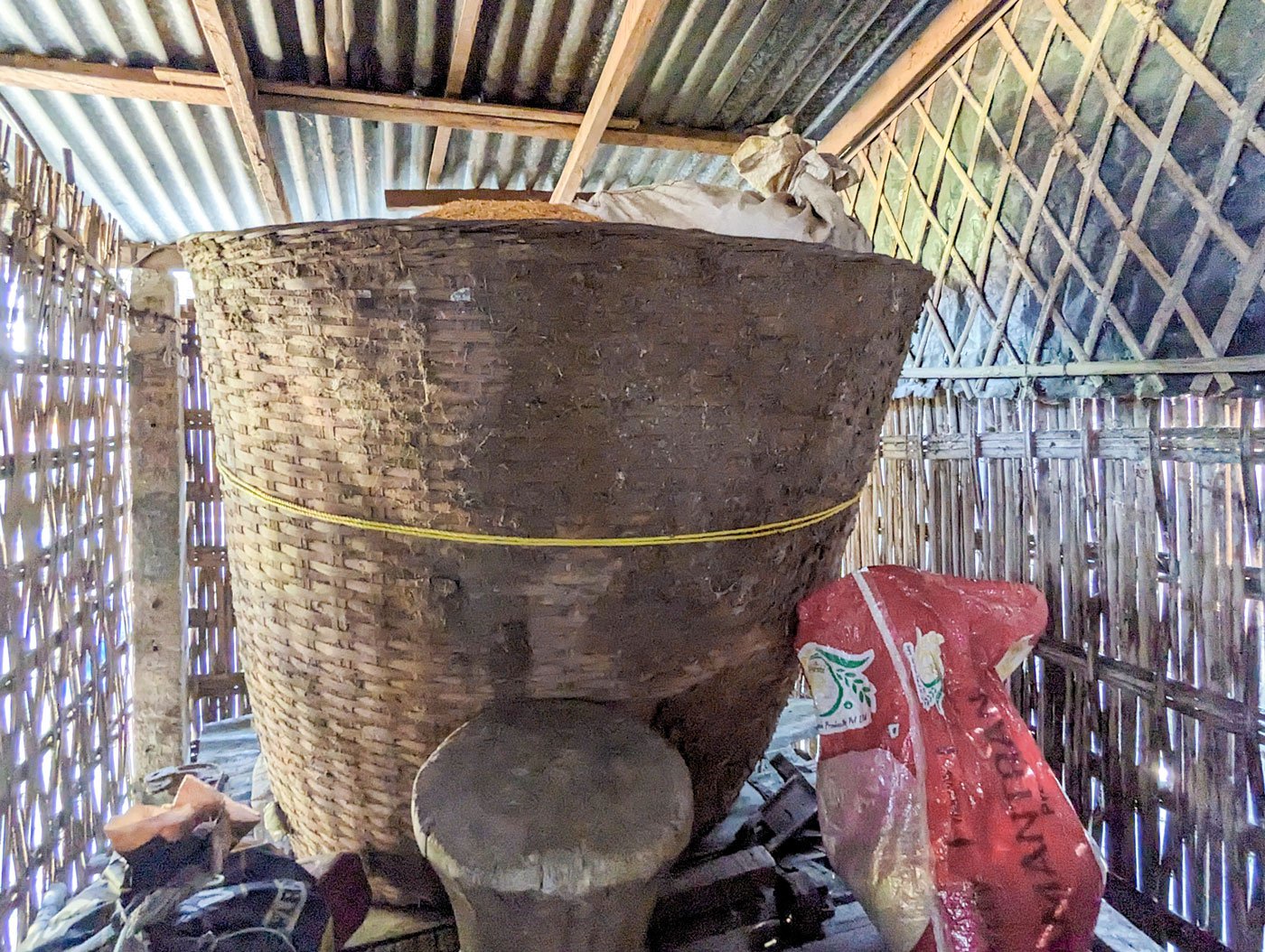
Left: Baban carries a half-done duli through harvested rice fields in Alipurduar. Right: The baskets are used to store harvested paddy for farmer's consumption over the next year. It is plastered with gobar (cowdung) so that the gaps in the basket are filled up, preventing the rice grains from falling out
*****
The migrant Baban will spend mid-October to December in West Bengal, and then return home to Bihar for a short hiatus. Come February, he will leave for the tea estates in Assam and spend the next six to eight months of the tea picking season there. “There is no place in Assam where I haven’t been to... Dibrugarh, Tejpur, Tinsukia, Golaghat, Jorhat, Guwahati,” he reels off names of big towns and cities.
The bamboo baskets he makes in Assam are referred to as dhoko . In relation to the duli, the dhoko is much smaller in height – all of three feet. These are used while picking tea leaves. He makes as many as 400 baskets in a month, often on order from tea estates who provide accommodation and bamboo while he is at work.
“ Baans ka kaam kiya, gobar ka kaam kiya, maati ka kaam kiya, kheti mein kaam kiya, ice cream ka bhi kaam kiya… [I have done bamboo work, I have done clay work, I have worked in cow dung, I have been practising agriculture, and I even sold ice-creams for a living.]” says the versatile Baban, describing his work through the year.
If basket orders in
Assam fall short, he makes a detour to Rajasthan or Delhi and sells ice creams
as a street vendor. There are other men in his village who do the same, so he
hops onto the bandwagon when necessary.
“
Rajasthan,
Delhi, Assam, Bengal - my whole life is spent between these places,” he says.
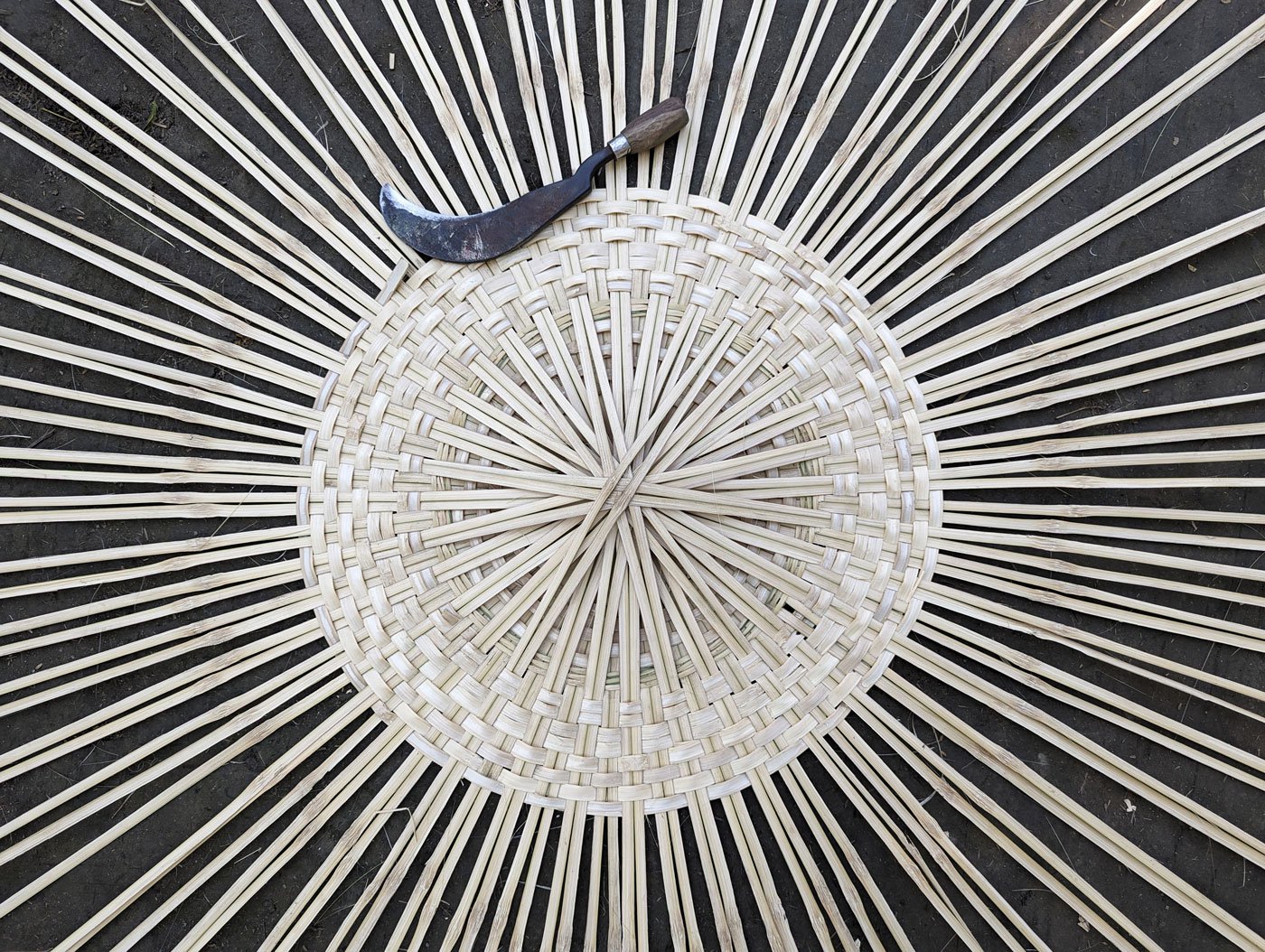
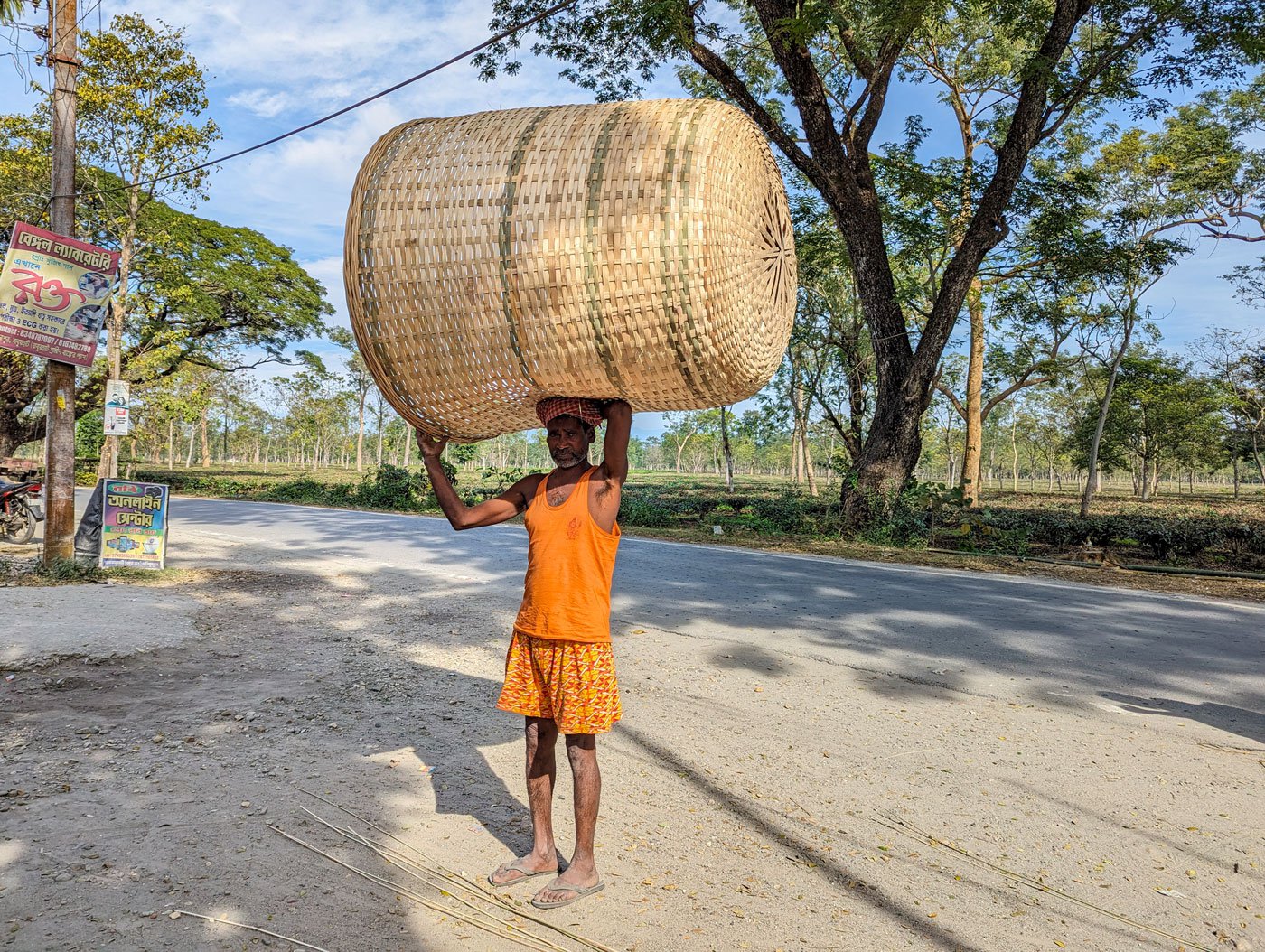
Left: To prepare the base of the duli , the weaver has to make careful calculations and it is a skill that takes a long time to master. The base maintains the balance of the basket. Right: Baban is ready to deliver his completed duli . An expert weaver, he takes only a day to make the basket
Despite his decades as a craftsman, Baban is not registered and does not have a artisan identity card ( Pehchan card) issued by the Office of the Development Commissioner of Handicrafts (under the Ministry of Textiles). It gives the artisan a formal identity to avail of various government schemes and access to loans, pension, eligibility for awards recognising craftsmanship, as well as skill upgradation and infrastructure support.
“There are lots of us [craftspersons], but who is bothered about the poor? Everyone is after their own pockets,” says Baban, who doesn’t even have a bank account. “I have brought up my eight children. Now, for as long as I can muster the energy, I will earn and eat. What do I want more than this? What [else] can one do?”
This story is supported by a fellowship from Mrinalini Mukherjee Foundation (MMF).
